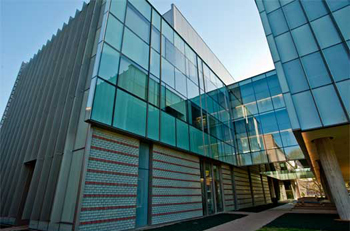Rice’s Brockman Hall for Physics is known for cutting-edge research on everything from gold nanoparticles to golden celestial bodies, and now the state-of-the-art facility is itself Gold.

Brockman Hall for Physics, which was dedicated in 2011, has earned LEED Gold certification by the U.S. Green Building Council. According to KieranTimberlake, the architectural firm that designed Brockman Hall, a Gold rating is an extraordinary achievement for a physics lab because of the energy needed to conduct experiments within a highly controlled environment.
The 110,000-square-foot facility that is home to dozens of experimental, theoretical and applied physicists from the departments of Physics and Astronomy and of Electrical and Computer Engineering recently earned Leadership in Energy and Environmental Design (LEED) Gold certification by the U.S. Green Building Council.
LEED certification is an internationally recognized standard for the design, construction and operation of eco-friendly buildings. It is awarded to projects designed and built to universally accepted criteria for energy efficiency, material conservation, water efficiency, indoor environmental quality and stewardship of resources and sensitivity to their impacts.
According to KieranTimberlake, the architectural firm that designed Brockman Hall, a Gold rating is an extraordinary achievement for a physics lab because of the energy needed to conduct experiments within a highly controlled environment. The feat’s accomplishment was a result of the integrated efforts of Rice’s Facilities, Engineering and Planning Department, the design team and the construction contractor, Gilbane Building Company.
Designed and constructed in just 33 months and dedicated in March of 2011, the building has energy-saving and environmental features that include an energy-recovery system — the largest in a single air unit in Texas — that saves as much as 30 percent of the energy needed to cool the building in the summer. Another green innovation is the building’s dehumidification system, which turns Houston’s legendary humidity into an asset by capturing and returning 100,000 gallons of pure, clean water to Rice’s Central Plant each year.
“Domestic water consumption was slashed by 48 percent versus business as usual through the use of high-efficiency water fixtures,” said Richard Johnson, director of energy and sustainability at Rice.
Building materials were sourced locally, and construction was carefully planned to limit material transportation costs and emissions. “Almost 90 percent of all construction waste was recycled, which is enough volume diverted from the landfill to fill the Allen Center to a depth of 19 feet,” he said.
The building is composed of two parallel, rectilinear spatial “bars” that are oriented east to west and connected by glass-enclosed bridges across an open passage that admits natural light and outdoor breezes. This orientation also mitigates heat gain and maintains precise light and temperature levels inside.
“One of the amazing features about Brockman Hall is that the gap between the two bars acts as a natural chimney, and it creates breezes along the ground plane as air goes across the deck and fountain and then up” Johnson said. “Even on the hottest days of the year, it’s relatively pleasant.”
The larger south bar houses laboratories, faculty and research offices, a 150-seat lecture hall and a rooftop astronomical observatory. The elevated two-story north bar houses faculty, student and departmental offices and meeting spaces.
The open space beneath the north bar is framed by a “loggia” of tapered concrete columns that form an outdoor room, with shaded areas for class meetings, casual gatherings and circulation. Beneath this space lies a sensitive and sophisticated complex of laboratories. Designed for vibration-sensitive atomic, molecular and optical physics and condensed-matter research, the hermetically controlled basement laboratories are stabilized on a two-foot-deep concrete slab and isolated from all the building’s mechanical systems. State-of-the-art equipment supplies these labs with “clean” electrical power, chilled water and filtered air that is cleaned of submicroscopic dust.
Brockman Hall has been recognized with design awards from the Society for College and University Planning, the Texas Society of Architects and the American Institute of Architects’ Houston, Pennsylvania and Philadelphia chapters.


Leave a Reply